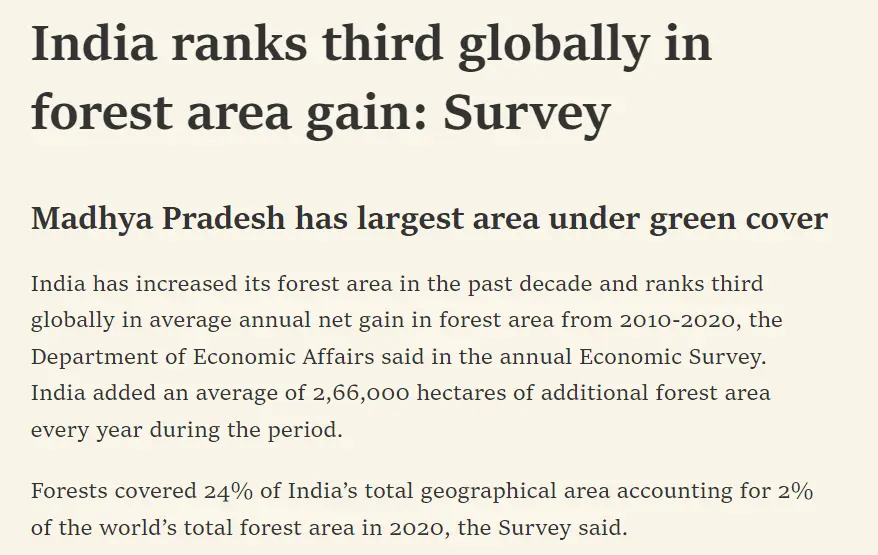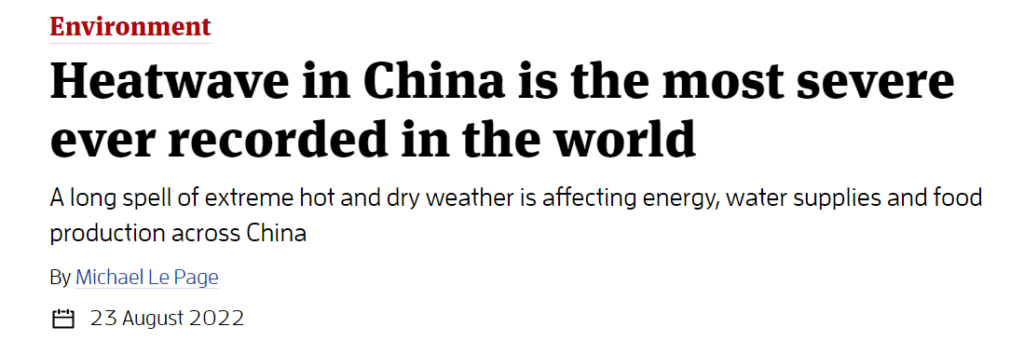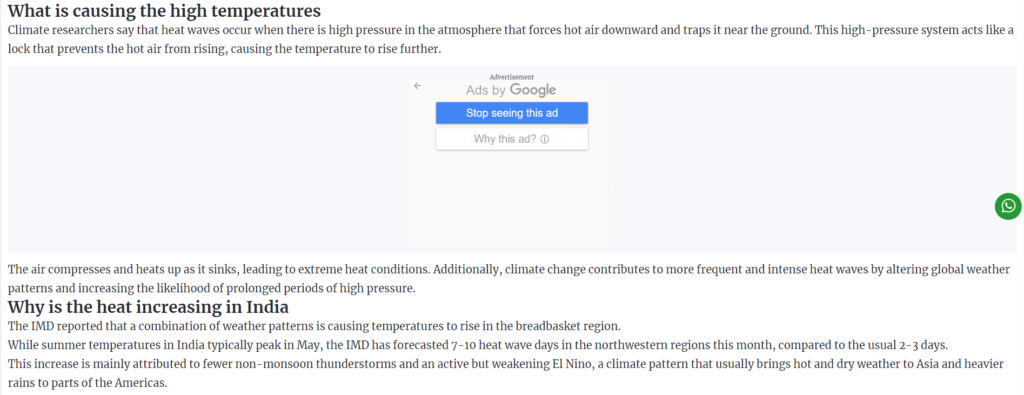In a recurring trend among Indian communist factions, Prime Minister Modi and capitalism are swiftly blamed whenever misfortunes arise. The current situation in northern India, suffering from severe heat waves, is no exception. New Delhi, the nation’s capital, recently recorded an alarming temperature of 52 degrees Celsius, a pattern observed across northern and western regions of the country. Bollywood actress Richa Chadha expressed her distress on social media, attributing the unbearable heat to widespread deforestation over the past five years. She criticized development projects and capitalism for their role in extensive tree-cutting, which she believes has contributed to the escalating temperatures.
Richa Chadha tweeted, ‘Do you and your kids deserve better ? In the last 5 years, India 668,400 ha of forest in the world, 2nd highest deforestation rate in the world. For detractors who will now say, ‘economic growth’ etc, we lost $69 Billion due to climate related catastrophes in 2019 alone. We CANNOT AFFORD to cut more trees. This year temperatures touched 52 degrees, next year, it’ll rise up, rendering our land uninhabitable eventually. Your ACs will fail, your kids will faint or worse from heatstroke. Please wake up, hold the regime accountable.,’
Do you and your kids deserve better ?
— RichaChadha (@RichaChadha) May 30, 2024
In the last 5 years, India 668,400 ha of forest in the world, 2nd highest deforestation rate in the world.
For detractors who will now say, ‘economic growth’ etc, we lost $69 Billion due to climate related catastrophes in 2019 alone. We… pic.twitter.com/JY4JwOxWi8
Trinamool Congress Rajya Sabha MP Jawahar Sircar tweeted, ‘Blazing Heat Wave is thanks to India’s loss of massive 2.33 million hectares of tree cover! Most of it during Modi’s regime when all environmental laws were amended to help cronies destroy forests. My dissent in 2 Parliamentary Committees was overruled.’
Blazing Heat Wave is thanks to
— Jawhar Sircar (@jawharsircar) May 30, 2024
India’s loss of massive 2.33 million hectares of tree cover!
Most of it during Modi’s regime when all environmental laws were amended to help cronies destroy forests.
My dissent in 2 Parliamentary Committees was overruled. https://t.co/lcspdU1o9e
This article will scrutinize the accusations leveled against the actress and politician concerning India’s purported lack of leadership in forest conservation. Additionally, we will analyze the various factors contributing to the sharp rise in temperatures.
Fact Check
Is India Rampantly Deforesting Under PM Modi’s Regime?
Contrary to popular claims, various reports suggest a different narrative. A report from The Hindu, published on January 31, 2022, highlights that India has actually increased its forest area over the past decade. According to the Department of Economic Affairs’ annual Economic Survey, India ranked third globally in average annual net forest area gain from 2010-2020, adding an average of 266,000 hectares of forest annually. By 2020, forests covered 24% of India’s total geographical area, accounting for 2% of the world’s total forest area.

Similarly, a report by the World Resources Institute, published in October 2022, notes that India is among 36 countries that gained more tree cover than they lost between 2000 and 2020. Approximately 59% of the 130.9 million hectares of global tree cover gain during this period occurred in temperate and boreal forests, with the remaining 41% in tropical and subtropical forests. Significant tree cover gain was noted in Russia, Canada, Brazil, the United States, Indonesia, China, Thailand, and India, largely due to forest regeneration and the regrowth of trees on abandoned agricultural land.
Further corroborating these findings, a report from the Press Information Bureau (PIB) dated March 13, 2023, stated that the total forest cover in India, as per the latest ISFR 2021, is 713,789 square kilometers, accounting for 21.72% of the country’s geographical area. This assessment revealed an increase of 1,540 square kilometers in forest cover and 721 square kilometers in tree cover since the previous ISFR 2019 assessment, totaling an overall increase of 2,261 square kilometers in forest and tree cover at the national level.

These reports clearly indicate that under PM Modi India is not engaged in rampant deforestation. On the contrary, the country is witnessing a significant increase in forest area and tree cover, reflecting a robust commitment to afforestation and environmental conservation.
Is India the Only Country Experiencing Severe Heat Waves?
No, heat waves are a global phenomenon, affecting countries across all continents. Australia, Europe, the United States, and Africa all experience extreme heat and heat waves. According to the European Union’s climate monitoring service, report published on May 8, 2024, the world has just experienced its hottest April on record, marking an unprecedented 11-month streak of record-breaking temperatures. The Copernicus Climate Change Service (C3S) revealed in its monthly bulletin that each month since June 2023 has been the hottest ever recorded for that month compared to previous years. Severe Weather Report noted that the heatwave persisted into April, with temperatures exceeding 30°C in southern Europe, setting the first-ever daytime record for April. The highest temperature was recorded in Zenica, Bosnia & Herzegovina, at 33.3°C on April 14, 2024.

According to The New York Times, Europe has been warming at twice the global average since 1991, with 23 of the 30 most severe heat waves since 1950 occurring after 2000. The World Meteorological Organization reports that five of these heat waves occurred in the last three years alone. Nature journal estimated 62,862 heat-related deaths in Europe in 2022, with Italy, Spain, Germany, France, the United Kingdom, and Greece recording the highest summer heat-related mortality rates.

In the United States, The Economic Times reported in July 2023 that millions of people have been affected by heat waves, with forecasters predicting a particularly hot summer. Phoenix, Arizona, is expected to surpass a decades-old high-temperature record, while over 90 million Americans endure temperatures above 90°F. Scientists warn that the severity of heat waves is escalating in our warming world.
China also faced a severe heat wave from June to August 2022, affecting several provinces and municipalities. Weather historian Maximiliano Herrera described it as the most severe heat wave recorded anywhere in the world.

Clearly, the trend of heat waves is not unique to India. It is a global issue, not something that can be solely attributed to the policies of any single administration. The entire world is grappling with the consequences of rising temperatures, making it misguided to blame the ruling administration for a phenomenon that is worldwide in scope.
Is Deforestation the Sole Cause of Heat Waves?
Definitely not. A report from Business Standard highlights multiple factors contributing to heat waves. Climate researchers explain that heat waves occur when high atmospheric pressure forces hot air downward, trapping it near the ground. This high-pressure system acts as a barrier, preventing the hot air from rising and causing temperatures to soar. As the air compresses and heats up while sinking, extreme heat conditions develop. Additionally, climate change exacerbates the frequency and intensity of heat waves by altering global weather patterns and increasing the likelihood of prolonged high-pressure periods.

The Indian Meteorological Department (IMD) reported that a combination of weather patterns is driving temperature increases in India’s breadbasket region. While summer temperatures typically peak in May, the IMD forecasted 7-10 heat wave days in northwestern regions this month, compared to the usual 2-3 days. This rise is mainly due to fewer non-monsoon thunderstorms and an active but weakening El Niño, a climate pattern that usually brings hot, dry weather to Asia and heavier rains to parts of the Americas.
Moreover, Times Now reported that Delhi and much of northern and central India are experiencing heat waves largely because these areas are far from oceans, which help regulate temperatures and humidity. The weather in Delhi is heavily influenced by dry continental air. Tropical air masses from the Thar Desert and other hot, dry regions to the west and northwest of India bring additional heat, exacerbating the heat wave conditions. The report also noted that while loss of tree cover in cities can contribute to rising temperatures, it is just one of many factors.

Conclusion
India’s tree and forest cover have been steadily increasing year by year. As the nation marches towards becoming a developed country, the need for more infrastructure and space is natural. To counterbalance this, India is rapidly advancing in renewable energy and actively planting more trees. Additionally, India is one of the four major economies on track to meet the Paris Agreement goals. In 2015, world leaders in Paris pledged to prevent global temperatures from rising more than 1.5°C.
Conversely, Richa Chadha, lacking a nuanced understanding of climate change, hastily blamed Prime Minister Modi and industrialist Adani for the heat waves. Chadha has consistently opposed the Hasdeo project, and upon witnessing the recent heat waves, she quickly seized the opportunity to link them to her advocacy against the project, despite the broader and more complex causes at play.
| Claim | India is the top country in cutting down trees |
| Claimed by | Richa Chaddha and Jawahar Sircar |
| Fact Check | Misleading |








